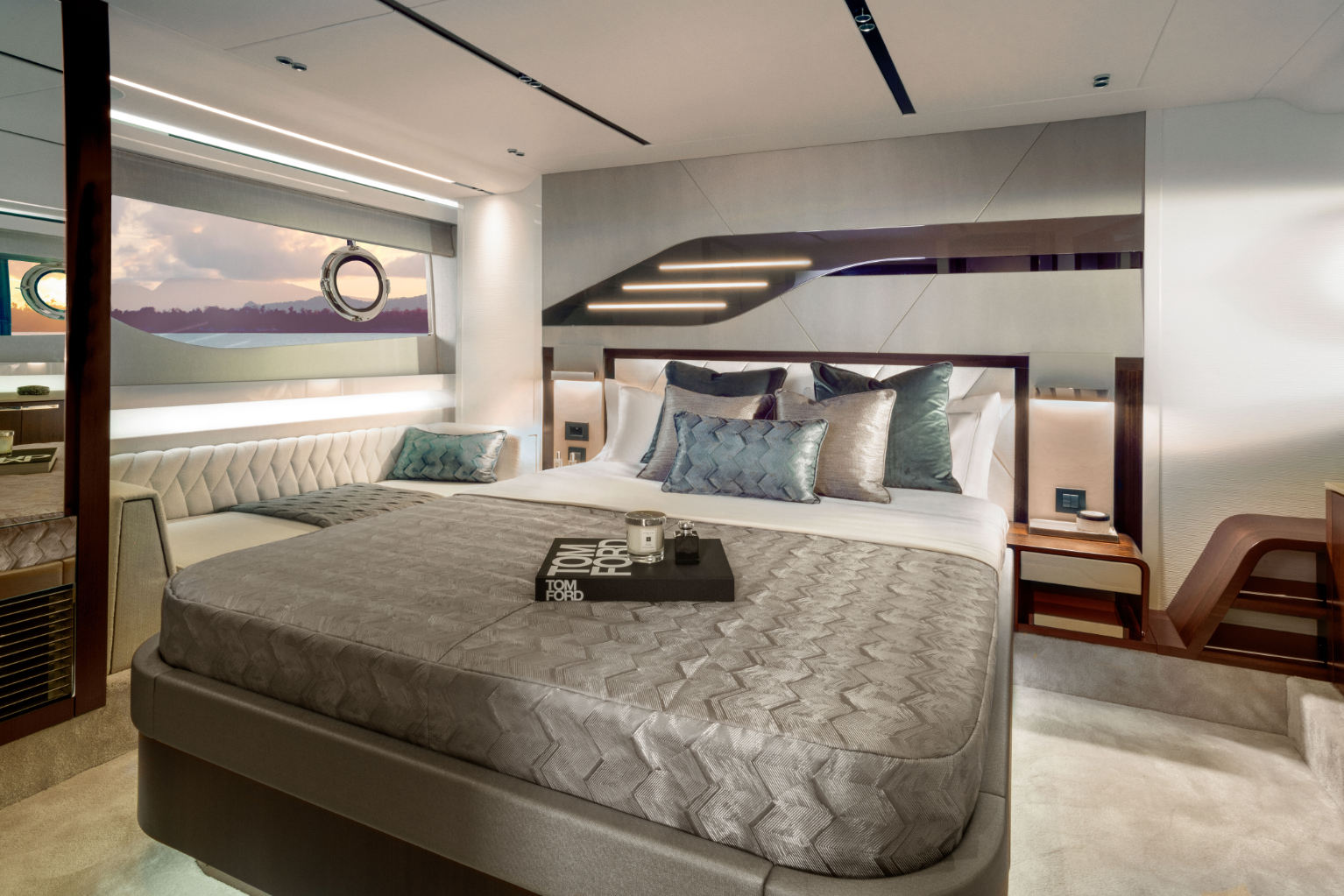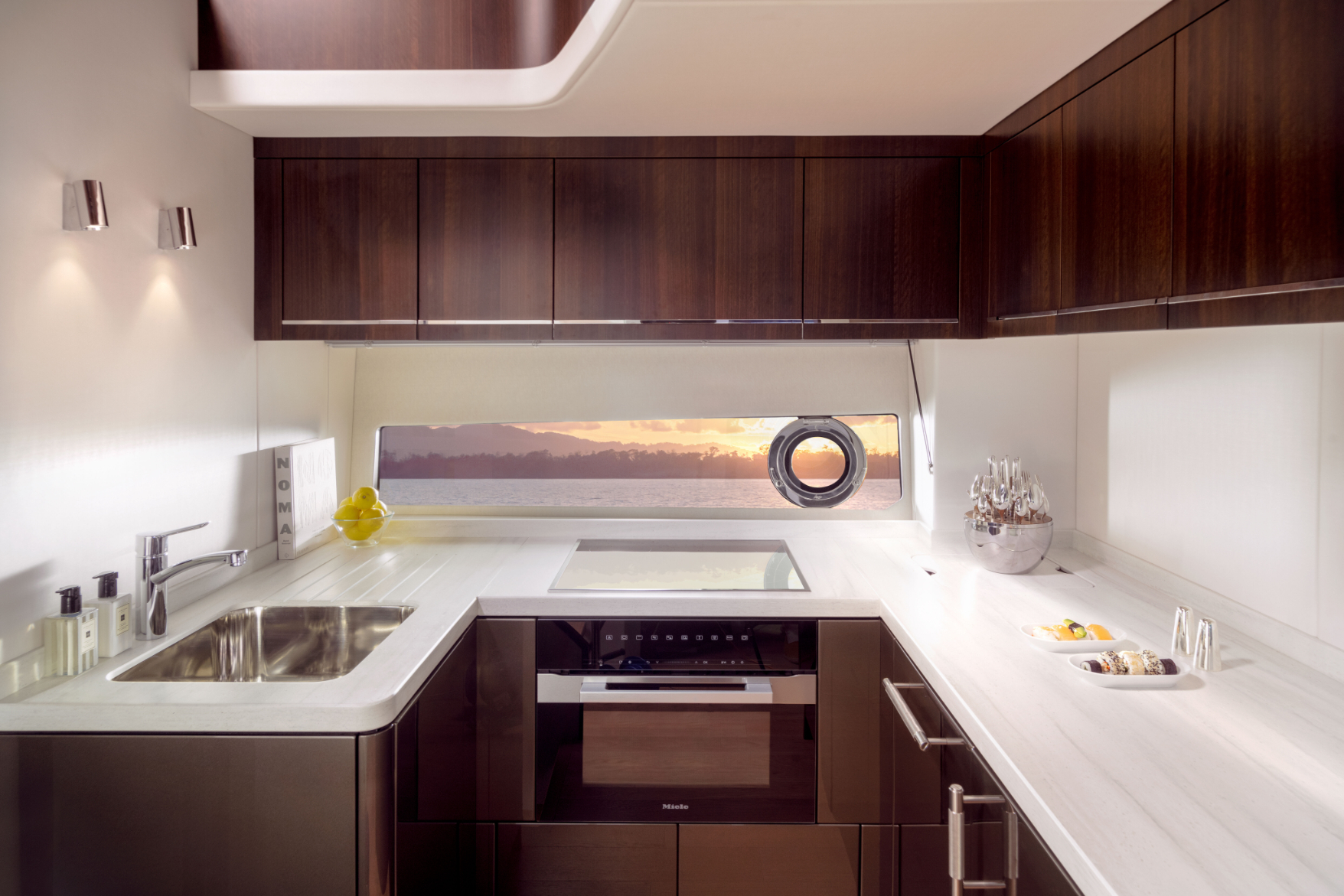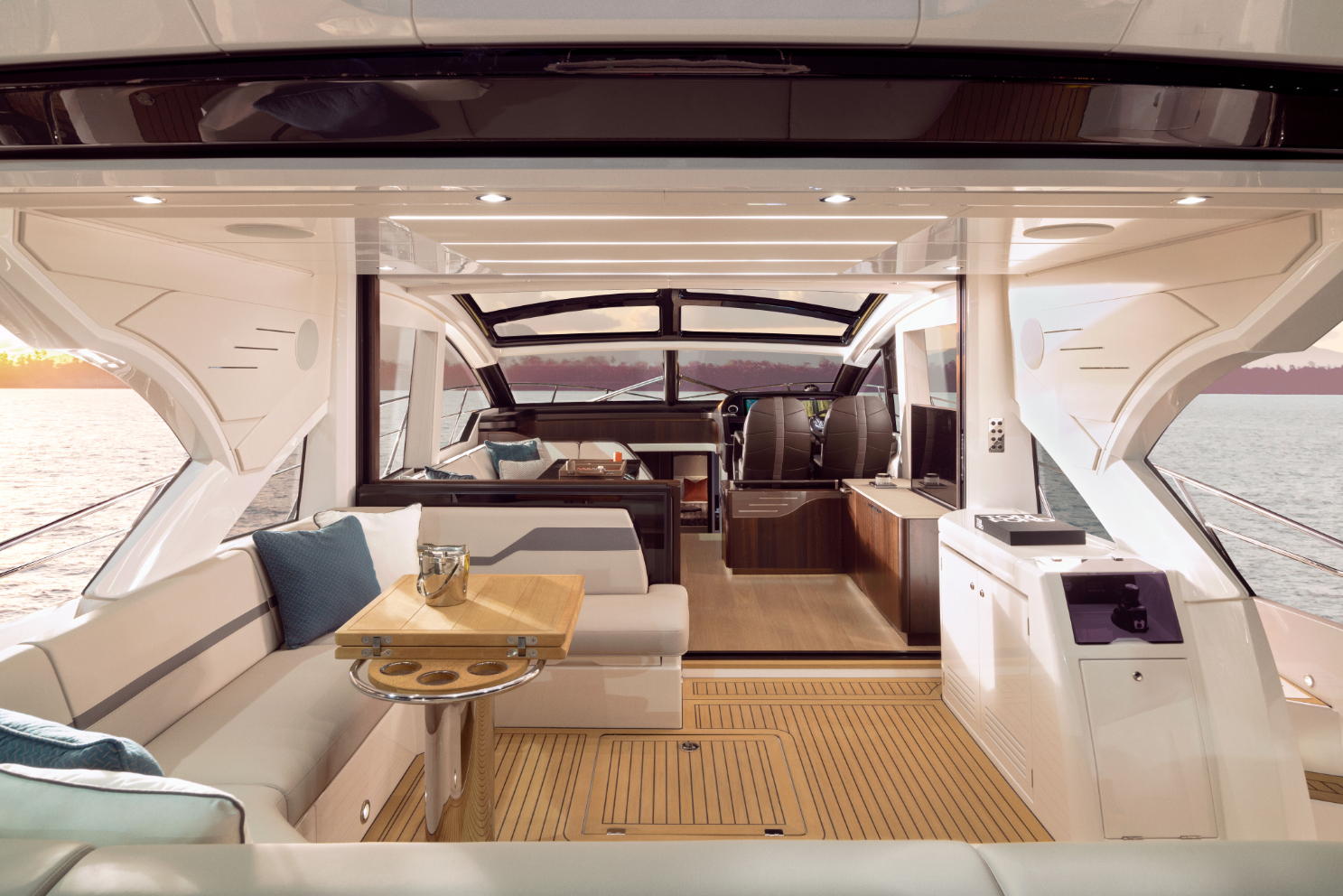Smooth innovator
The Sunseeker Predator 60 EVO improves on an already great design, as Jack Haines details, and the result points the way of the future for this celebrated British brand.
10 March 2022
There is a theme developing with my tests of the Predator 60. Ten years ago, I tested a previous generation of the boat in thoroughly miserable weather, but the boat acquitted itself well.
Fast forward to January this year and I arrive at Sunseeker’s West Quay Road facility in Poole, UK, before the sun rises with rain pouring off the shed roof.
Don’t let the photos, which were shot by Sunseeker in Florida, fool you. The rain is a remnant of Storm Brendan, which had been forecast, but with such a tiny window to test the boat before it headed north to Helsinki, we have to give it a go.
Out of the protection of Poole Harbour, we ease on to the plane, our sights on Old Harry Rocks. There is little to suggest that a howling storm was blowing across the bay just hours before aside from a light swell that picks up as we clear the lee of the Isle of Purbeck.
The Predator 60 EVO is a happy beast in these conditions, romping confidently across the undulating surface. We’re running in step with our 76 Yacht chase boat and, frankly, struggling to keep up.
The stabilised 76 is not only longer and heavier than the 28-tonne 60 EVO, it’s faster at the top end too because the boat we have on test has the smallest engines on offer: twin 900 hp Volvo Penta D13s. Upgrades to 1,000 hp or twin 725 hp IPS pod drives are available.
The good news is that, unless you’re going to order a very heavy spec, the standard engines feel more than up to the job of punting the boat through the water.
True, we don’t have a tender in the garage, nor is there a gyro fitted, but during our two-way performance runs we get from 0–20 knots in 13.1 seconds and top out at 33.5 knots.
The hull is shared with the Predator 57, but in developing that boat into this new model, Sunseeker implemented a strict weight-saving regime.
The use of carbon fibre is extensive, most obviously in the beautiful (and enormous) sunroof – apparently so light two people could pick it up – but also in the transom and tender garage moulding where a whopping 400 kilograms has been saved.
You don’t lop off that much weight and have it go unnoticed from behind the helm where the boat feels alert, poised and eager to plane.
Most of Sunseeker’s sleek new offerings have found dockside homes in Europe. Still, Australian admirers won’t have to wait long according to Brad Rogers, Director of Sales at Sunseeker East Coast Australia.
“We’ve received a lot of interest and a Sydney client has ordered a highly specced boat that will be arriving in April,” he reveals.
Not having experienced the ferocity of Australia’s fringing seas, I’m unsure whether I would tick the option for Sunseeker’s Hydro Performance Pack, but I feel the 60’s upgraded multifunction wheel is compulsory.
This is the first time I have used one of these wheels with the buttons under my thumbs connected to the two MFDs. The functionality takes a little bit of getting used to but, after a bit of practice, they work very well.
Simrad’s lovely 16-inch MFD touchscreens are a bit of a stretch away from the helm seat, so having hard buttons arranged around the steering wheel hub is very useful when you’re bouncing around at sea.
The click of a button can change which display is active, swap between screens, zoom in and out of the chart, and even mark and set headings for waypoints.
The layout and design of the helm are very good and an improvement over the 57. It’s more digitally savvy too, with a wireless charger for a smartphone incorporated into the cubby on the left-hand side and a mount for an iPad with built-in charging dock subtly mounted just above it. Given how many people use an iPad as their secondary source of navigation data, this seems a prudent move.
There is a sense of not wishing to throw the baby out with the bathwater on the 60 EVO. Sunseeker sold more than 100 of the boat it’s replacing, so has sensibly carried over the bits that worked, namely the spectacular roof and drop-down cockpit doors.
They give the boat a two-in-one versatility that few rivals can compete with – in good weather, open the roof and drop the cockpit doors into the deck and you’re as exposed to the elements as you could hope to be on a hardtop sport cruiser.
In poor weather, keep everything closed, pump up the Eberspächer and go winter boating in a T-shirt.
Because the sunroof has eight glass panels, even when it’s closed there’s still a great connection to the outside. Huge ladles of natural light fill the main deck. The roof and large void that it retracts into make the boat appear rather tall – the black superstructure is an attempt to lower the boat’s visual height.
The overall design is a bit too fussy for my taste, but the benefits on board are plain to see.
The small touches imply a more finessed product, from solid metal handles on the drawers and doors and stainless-steel details embedded in the cabin doors to the intelligent use of backlighting and dimmable spotlights, controlled either via hard switches or Sunseeker’s CM8 central control system.
The designers have not cast aside function to benefit form, nor have they dismissed the important practicalities of boating.
The galley is a fine example of this with ample stowage, cupboard doors that lock shut with handsome metal catches, tall fiddles along drawer edges and bespoke storage for crockery including, rather charmingly, a tea set.
Opposite, there is a lower dinette that some may see as surplus to requirements, but others will view as a cosy spot to retire to in poor weather or have a morning coffee away from prying eyes on the main deck.
Alternatively, this area can be made into an extension of the galley with more counter space, a wine cooler, washing machine and extra fridge.
Even without this galley extension, the catering facilities compare favourably with most rivals, especially when it comes to cooling space.
The under-counter fridge in the galley is supported by a drawer fridge in the deck saloon and another small unit in the cockpit wet bar. An icemaker and barbecue grill are cost options in the cockpit worth having, given the distance to the galley.
The three-cabin layout isn’t up for change, but you can have scissor berths in the VIP cabin rather than the fixed double if you need more versatility.
This cabin is ensuite to the day head, shared with the bunk bed third cabin across the landing. The full-beam master ensuite stands out for its spaciousness and lack of obstructions overhead or underfoot.
With more than 1.82 metres of headroom and a flat floor, it’s easy to move around the island berth, though with just one hanging wardrobe and a small chest to port, it feels a little down on storage space compared to some rivals.
Whether with shafts or IPS, the engines are in the same spot just aft of the master suite bulkhead.
On the pod option, jackshafts connect the engines to the pod drives, but this means the pods are tucked away beneath the crew cabin, potentially making involved maintenance work quite tricky.
The engine room itself fairs better and is accessed via a hatch in the cockpit sole. There’s enough space to stand with a stooped head and good access around the blocks to make service checks.
There’s some intrusion from the tender garage moulding, but it’s not bad, and the amount of insulation down here explains why the boat is so quiet at cruising speed.
The crew cabin isn’t a space I would want to spend much time in, but with good access via a door in the transom, it makes a great area to store bulky items without having to lift the tender garage door.
It’s tempting to dismiss the 60 EVO as a Predator 57 with tweaked styling and a new colour scheme, but spend some time on board and you realise that Sunseeker has put the work in to improve what was already a successful design.
If you have an award- winning blueprint, it doesn’t make sense to abandon it, and the subtle changes that have been made to the interior lift the boat to a higher echelon without spoiling what worked so well on the previous model.
Like the Predator 60 I tested ten years ago, this latest version demonstrates the sort of practicality and versatility that make it such a talented and stylish year-round cruising machine.













